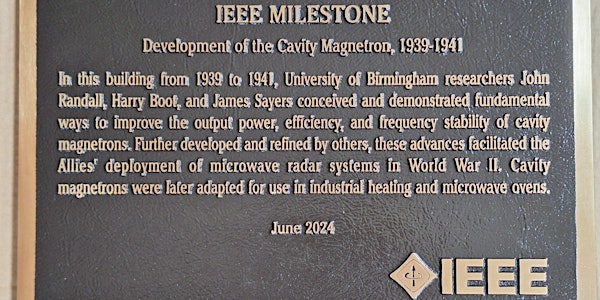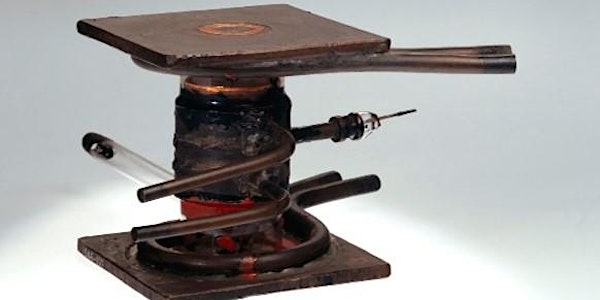

IEEE Milestone - Development of the Cavity Magnetron - UoBirmingham
IEEE Historical plaque unveiling to celebrate the development of the cavity magnetron by J Randall & H Boot & J Sawers at UoB in 1939
Date and time
Location
Poynting Building
Poynting Building Birmingham B5 7SW United KingdomAgenda
10:00 AM
Coffee from 10 am along with display of historical artifacts
11:00 AM - 11:05 AM
Welcome by the UoB
Prof Adam Tickell (UoB Vice Chancellor)
11:05 AM - 11:10 AM
The IEEE and the importance of preserving the history of Electrical Eng
Dr Thomas Coughlin (IEEE President)
11:05 AM - 11:10 AM
The IEEE Foundation and its support for the History Centre
Prof Sarah Spurgeon (UCL and IEEE Foundation)
11:10 AM - 11:15 AM
The IEEE Milestone Program
Prof David Michelson (Chair, IEEE History Committee)
11:15 AM - 11:20 AM
This milestone on the generation of high-power microwave energy
Prof Peter Grant (University of Edinburgh)
11:20 AM - 11:25 AM
The International importance of these developments
Dr Tim Hall (MIT Lincoln Laboratory)
11:25 AM - 11:40 AM
Unveiling of the Milestone plaque
Prof Adam Tickell (UoB Vice Chancellor)
Dr Thomas Coughlin (IEEE President)
11:40 AM - 12:00 PM
Closure of the session
Rod Muttram (IEEE UK&I Industry liaison and LMAG)
12:00 PM - 1:00 PM
Buffet lunch
1:00 PM - 4:30 PM
Technical Symposium, see separate agenda
About this event
- 8 hours
Background
In 1939 at the start of the war there was a need to efficiently achieve higher power microwave energy to enable the advance from land based into airborne radar. John Randall and Harry Boot at Birmingham produced, in 1940, their first working magnetron incorporating their novel resonant cavity design, which enabled the generation of hundreds of Watts of power at 10 cm wavelength. Subsequently the engineers at the General Electric Company (GEC) in Wembley, re-engineered this device for mass production, enabling it to generate well over a kilowatt of pulsed power. These high-power microwave pulses could then be transmitted from an antenna only centimetres long, reducing the size of practical radar systems and improving the resolution of targets. This enabled the realisation of British and American long-range night-fighter and anti-submarine airborne radar systems. This event celebrates these technical advances with the unveiling of an IEEE Historical plaque at the University of Birmingham on 4 June 2024.
Whereabouts
The venue, Poynting building, School of Physics and Astronomy, is located on the University of Birmingham main campus. The main campus is directly served by its own rail station, called University. Just eight minutes’ journey from New Street, the station makes the train a quick and convenient travel option from across the West Midlands and beyond. For all timetable information visit National Rail or check live departures from University on the campus map app.
The venue is within walking distance (under 10 minutes) from/to the Edgbaston Park Hotel that sits in landscaped gardens off Edgbaston Park Road, on the north east part of the University of Birmingham main campus.
Frequently asked questions
Yes due to venue capacity. Hence, we operate in first come, first serve.
The venue, Poynting Building, is centrally located on UoBirmingham main campus, 2-minute walk eastbound from the Joseph Chamberlain Memorial Clock Tower (aka Old Joe). Just eight minutes' journey from New Street, University train station makes the train a quick and convenient travel option.
Yes, there will be on display photographs, original magnetrons, and historical artefacts featuring the development of the cavity magnetron.